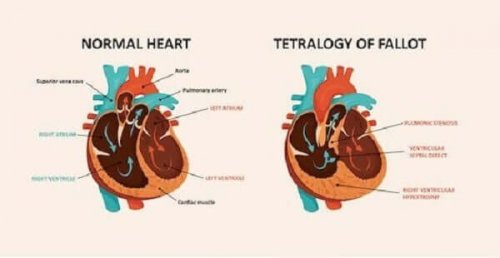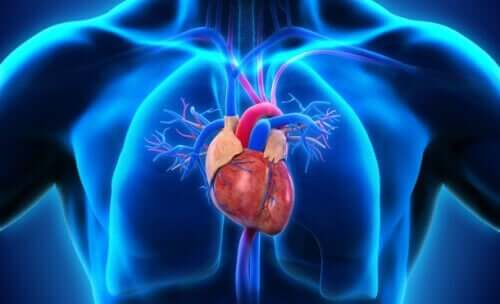Characteristics of Congenital Heart Disease

Congenital heart disease is a problem that affects approximately 1% of newborns. It happens during pregnancy, as the baby’s heart develops. In case you don’t already know, the word “congenital” means this pathology is already present at birth.
Statistics indicate that congenital heart disease is the most common birth defect. Thanks to advances in science, the number of adults with this problem is currently greater than the babies born with it.
What this means is that more people are surviving than dying from this condition. Of course, those who make it to adulthood require continuous monitoring in order to prevent complications.
What exactly is congenital heart disease?

You might think congenital heart disease is a single condition but there are many variations of it. It is, in fact, a group of diseases whose common characteristic is the presence of structural alterations in the heart.
These alterations happen due to a failure in the formation of the organ during the embryonic period. For instance, the baby’s heart begins to form from conception, but it isn’t until the eighth week of pregnancy that its development completes.
Normally, for the heart to form, a series of successive stages must fulfill. Generally, congenital heart disease occurs when some of these stages don’t complete in a timely manner. Thus, the result is an abnormal heart.
Causes
In the vast majority of cases, it’s impossible to establish the specific cause of congenital heart disease. Despite this, the World Health Organization (WHO) points out that some factors increase the risk of having one of these pathologies. These are:
- Genetic factors. Family history increases the risk of developing a congenital heart condition. Likewise, they’re usually part of chromosomal or genetic syndromes, such as Down Syndrome, DiGeorge Syndrome, and others.
- Infections. When the mother has infections such as syphilis or rubella, the risk of the embryo suffering from malformations increases.
- Nutritional condition. This is where a mother is either overweight or has an excess of vitamin A or lacks iodine or folate. She may also have a disease such as diabetes mellitus which increases the likelihood of abnormal fetal development.
- Environmental factors. Exposure to certain chemicals, the consumption of alcohol and/or tobacco, as well as the use of some medications, increase the risk of the development of congenital diseases.
Symptoms and types of congenital heart disease

The symptoms of heart disease appear either immediately after delivery or a few months later. Its main symptoms in a newborn child are:
- Difficulty eating
- Fast breathing
- Purple or bluish lips
- Stunted growth
Read also: The Parts of the Heart and their Functions
The different types of congenital heart disease fall into three groups, namely:
- Problems due to excessive blood flow through the lungs. There’s an increase in pressure and effort in the lungs in these types of pathologies. They include problems such as:
- Persistent arterial duct
- Interarticular or interventricular communication
- Atrial ventricular canal
- Problems with poor blood flow through the lungs. Because of them, the body doesn’t get enough oxygen. Thus, it leads to a blue or purple color on the lips. This can lead to problems such as:
- Tricuspid atresia
- Pulmonary atresia
- Transposition of the great arteries
- Tetralogy of Fallot
- Double right ventricular outlet
- Arterial trunk
- Problems due to poor blood flow to the body. Malformed heart cavities or blockages in blood vessels prevent the passage of blood into the body. They include coarctation of the aorta and aortic stenosis.
You may be interested: Heart Health: Oats and Apples
Other data to consider
To prevent congenital heart disease, a mother-to-be must have regular medical examinations during pregnancy. Also, they must only use medication authorized by the doctor who is monitoring them, and they should try to avoid exposure to harmful chemicals.
If the pregnant woman has diabetes mellitus, they must keep their blood sugar level under control. However, no matter how much a person takes care of themselves, it’s sometimes impossible to prevent congenital heart disease. This is because genetic factors play a huge role in it.
Congenital heart disease has different levels of severity. It all depends on the nature and severity of the malformation. Sometimes, the pathologies must be resolved as soon as the baby is born and, at other times, you can contain them while the child grows.
All cited sources were thoroughly reviewed by our team to ensure their quality, reliability, currency, and validity. The bibliography of this article was considered reliable and of academic or scientific accuracy.
- Granado, F. M., & de Cardiología Pediátrica, S. (2008). Epidemiología de las cardiopatías congénitas. Servicio de Cardiología Pediátrica, Hospital Infantil Universitario La Paz, Madrid.[Consultado el 10 de junio de 2013]. Disponible en www.secardioped/protocolos.es
- Friesen, R. H. (2010). Cardiopatía congénita. In Anestesia. Secretos. https://doi.org/10.1016/b978-84-8174-941-0.50061-6
- Born, D. (2009). 8. Cardiopatia congênita. Arquivos Brasileiros de Cardiologia. https://doi.org/10.1590/s0066-782×2009001300008
This text is provided for informational purposes only and does not replace consultation with a professional. If in doubt, consult your specialist.








